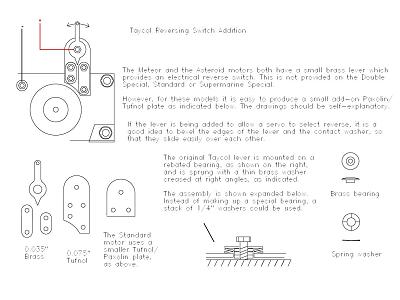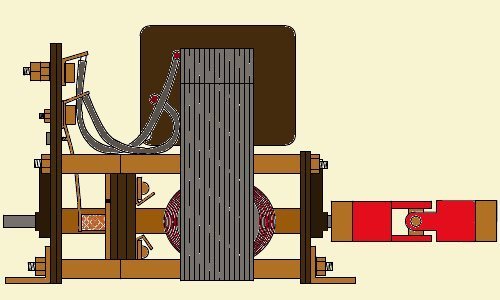Two Taycols (the Meteor and the Asteroid) have reversing levers which may be directly operated using this unit. While a servo may be mounted in any convenient position, here are the lines for a simple mount which may be fastened direct to a motor:...
Three other Taycols (the Double Special, Supermarine Special and Standard) come with twin coils, but no reversing lever. They are intended to be used with a single pole changeover switch connected to the two 'reversing' terminals. A P105 may readily be used to drive a servo operating a commercial switch, or a small 'add-on' brass 'Taycol-Type' switch can be made as illustrated here....
The standard Taycol Supermarine requires a double-pole changeover switch. Again, the P105 can operate any suitable commercial double-pole switch, or a somewhat larger 'Taycol-type add-on' can be made as below:...
Jet (both gas and water) boats and steam engines share a requirement to operate reverse mechanically rather than electrically, and may use a third channel to select reverse via a servo operated lever. Occasionally ESCs have been developed which will output a servo signal automatically to perform this service when polarity changes to reverse, but they are not common items. MicroGyro used to do such an ESC (currently unavailable). If such a device is used, reversing a Taycol can be performed in the original design manner, using an ESC and radio in a completely standard way while having a servo automatically throw the 'reverse selector lever' when the Tx stick moves to reverse.
Action Electronics (now Component Shop) have recently brought out a seperate reversing unit which allows this facility to be added to any ESC - the P105 (details available
here.) Though not designed for the unusual requirements of a Taycol, it will provide this service. However...
Note that the 'Taycol-type' switches illustrated below were originally hand operated, and could require a little sideways pressure to make them operate smoothly. This is why there is a 'spring' washer included in the switch assembly, allowing a small sideways movement.
If such a switch is to be operated via a servo, it is recommended that the contact edges of both the lever and the contact washer are bevelled slightly to ensure that reliable operation occurs.
The P105 uses a small microprocessor to control a servo at the polarity change point. This can be quite sensitive to power-line interference. I matched it with a 'cheap chinese' ESC to give it deliberately poor test conditions, and I needed to put TWO ferrite suppressors on EACH power line from the Taycol (a ring AND a tube) before I could achieve reliable switching. Taycols do not provide a clean electrical environment!
I have been experimenting with a purpose-designed relay switching circuit for a while now to perform this function, and think I have now
got it to work under all conditions). However, if you can suppress your power feed effectively, the P105 plus a mechanical switch can work.

